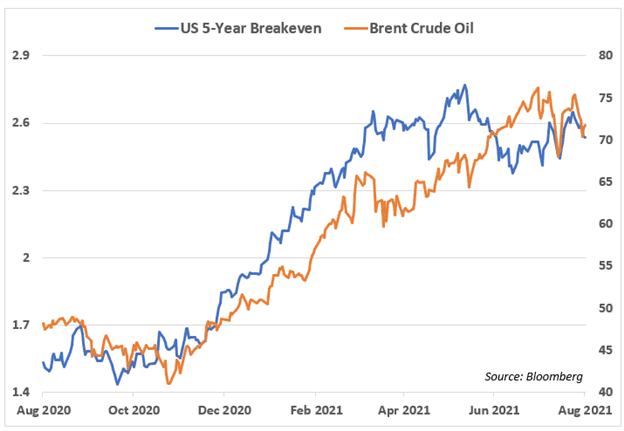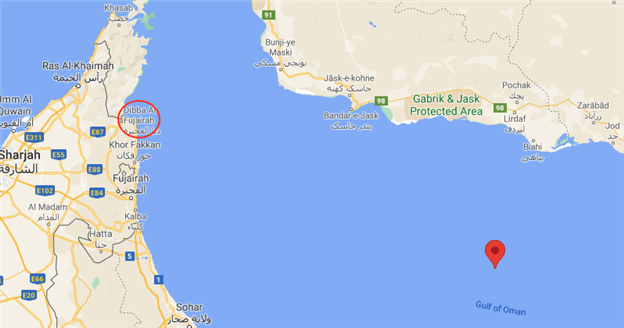CRUDE OIL, BRENT, INFLATION, DELTA VARIANT, COVID-19, IRAN - TALKING POINTS:
- Crude oil prices could rise as tensions with Iran stoke supply disruption fears
- Delta variant spread may derail global recovery and impede crude oil’s gains
- Between politics and global demand, which factor will be the most influential?
Crude oil prices rose over 30 percent year-to-date as increased vaccination rates and reopening after pandemic-inspired lockdowns led traders to bet on a boom in economic activity. It seems only natural that the need for key growth inputs would rise in this scenario. Pent up demand for travel – both recreational and commercial – was a key drivers envisioned in this model.
Crude oil prices rising with inflation expectations as demand picks up

However, with a new strain of Covid-19 spreading throughout the world, a shadow of doubt is now being cast on future growth prospects and thereby on demand prospects for key raw materials, like oil. Rising tensions between the US and Iran may give the Brent crude benchmark some respite however. The multi-trillion dollar question is, will this be enough to reverse the macro trend?
Demand in Danger?
The spread of the Delta variant poses the biggest fundamental risk to crude oil prices as the new and more contagious strain spreads across continents. Those who are not vaccinated are the most vulnerable and account for the largest number of infected people. As I wrote previously, the success of the vaccines against the variant is a significant market factor.
The world’s three largest oil consumers – the US, China and India – are all experiencing a notable uptick in the number of Delta infections. The latter country – where the variant was first detected – is finally seeing cases recede somewhat after an initial spike. In China however, the virus continues to spread from the coast to the cities, with officials warning against unnecessary travel.
Infections in the United States continue to rise even with roughly half of the population vaccinated. Having said that, Director of the US National Institute of Allergy and Infectious Diseases Anthony Fauci said the country is not headed towards another mass lockdown. While this news is positive for oil prices, the cumulative effect of quasi-restrictive policies from top crude consumers is nevertheless a fundamental headwind.



Political Spillover: US-Iran Tension
Tensions between the US and Iran remain high despite efforts to re-establish the Joint Comprehensive Plan of Action (JCPOA) i.e. the Obama-era “nuclear deal”. There are a plethora of issues stocking antagonism between Tehran and Washington beyond generally competing geopolitical interests that are driving a wedge between the two.
One major setback was the foiled kidnapping of Masih Alinejad, an outspoken Iranian-born critic of the Islamic republic now based in the US. Another is a now-void prisoner swap agreement that seemed like it might move forward just over a month ago. The most recent escalation revolves around maritime matters.
Iran was recently accused of ordering a drone strike against the Mercer Street oil tanker off the coast of Oman. US and Israeli intelligence concluded that Tehran was behind the attack. US Secretary of State Antony Blinken warned that “an appropriate response” is coming, with Iranian officials volleying back that any attack will be met with a “strong and crushing” return of force.
This comes on top of a potential hijacking of an oil tanker off the coast of the United Arab Emirates in the Gulf of Oman, 60 miles east of Fujairah. The British Navy is still confirming the information, but officials are alleging it was conducted by Iran-backed gunmen. Recent reports indicate that the ship is now safe, but the tensions triggered by the incident remain.
Map: Gulf of Oman, Coast of UAE Where Oil Tankers Were Attacked and Hijacked

Source: Google Maps
The geopolitical fragility and tensity of the situation in the current pandemic-struck environment means there is an asymmetric risk of high volatility from an escalated incident or development. The newly-elected President Ebrahim Raisi – the second-most powerful politician in Iran behind Supreme Leader Ali Khamenei – could be a new risk traders have to incorporate into their models.
Preceding the June 18 election, many policymakers and traders were expecting for a reboot of the nuclear agreement to be almost inevitable. However, following Raisi’s ascent to power, the rhetoric has changed. Now, Iranian officials are taking a harder line and seeking to get concessions from the US.
These include provisions that prohibit the reimposition of sanctions and prevent amendments to strengthen and elongate the deal. Given the most recent incidents in the Gulf of Oman that Iran is accused of orchestrating, its bargaining power may be diminished, so future talks might yield relatively little progress. Consequently, an extended period of geopolitical tension and uncertainty may keep supply shock fears afloat and underpin oil prices.



Crude Oil Price Outlook
Crude oil prices have shed almost 7 percent since July 30, and are now closing in on support at $68.52. Brent has frequently tested near this barrier as both resistance and support, with the most recent occurrence in mid-late July before springing back and rising around 10 percent. While past performance is not indicative of future results, another such instance is not out of the question.
Crude Oil Prices - Daily Chart

Crude oil chart created using TradingView
Having said that, if crude oil breaks support with follow-through, the next level to monitor may be $64.60. It should also be noted that the fundamental uncertainty of the situation means traditional approaches to technical analysis may not hold. Volatility from the fundamental backdrop could make plotting technical levels difficult.
In short, crude oil prices are torn between the downward pressure of an uncertain demand backdrop thanks to the Delta variant, and the upward pull stemming from worries about politically-driven supply disruptions. On balance, recent history suggests that – while geopolitical turmoil can drive crude oil prices to spike – it is ultimately the fundamental supply/demand calculus that prevails.






